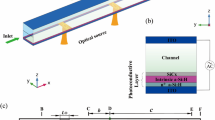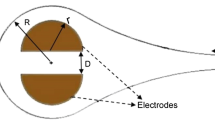Abstract
Numerical analyses of the recently proposed micro mixer based on periodic electroosmotic flow through a constriction were conducted. The validity and accuracy of the numerical model developed were verified experimentally. The model allows the prediction of operating parameters such as alternating current (AC) amplitude and frequency for optimum mixing. For accurate simulations of flow behavior such that optimum operating conditions could be determined, the electromigration effect of charged fluorescent dye added to the fluid stream must be considered. This effect, which is generally ignored, can be incorporated in the convection diffusion equation. Important factors that govern the mixing efficiency of the mixer, such as the contact area between the two fluids and the amplitude of fluid interface oscillation were quantified based on experimental and numerical results. Detailed error analyses were performed to investigate the sensitivity of simulation results to the variability of constriction width, diffusion coefficient, and fluorescein ion mobility. This also provides an understanding on the fabrication requirement for efficient mixing.












Similar content being viewed by others

References
Bahga SS, Bercovici M, Santiago JG (2010) Ionic strength effects on electrophoretic focusing and separations. Electrophoresis 31(5):910–919
Chang CC, Yang RJ (2007) Electrokinetic mixing in microfluidic systems. Microfluid Nanofluid 3(5):501–525
Chen Z, Bown M, O’Sullivan B, MacInnes J, Allen R, Mulder M, Blom M, van’t Oever R (2008) Performance analysis of a folding flow micromixer. Microfluid Nanofluid 6:763–774
Cheng YF, Wu S, Chen DY, Dovichi NJ (1990) Interaction of capillary zone electrophoresis with a sheath flow cuvette detector. Anal Chem 62(5):496–503
Culbertson CT, Jacobson SC, Michael Ramsey J (2002) Diffusion coefficient measurements in microfluidic devices. Talanta 56(2):365–373
Du W-B, Fang Q, Fang Z-L (2006) Microfluidic sequential injection analysis in a short capillary. Anal Chem 78(18):6404–6410
Erickson D, Li D (2002) Influence of surface heterogeneity on electrokinetically driven microfluidic mixing. Langmuir 18(5):1883–1892
Fu LM, Yang RJ, Lin CH, Chien YS (2005) A novel microfluidic mixer utilizing electrokinetic driving forces under low switching frequency. Electrophoresis 26(9):1814–1824
Gan HY, Lam YC, Nguyen NT, Tam KC, Yang C (2007) Efficient mixing of viscoelastic fluids in a microchannel at low Reynolds number. Microfluid Nanofluid 3(1):101–108
Glasgow I, Aubry N (2003) Enhancement of microfluidic mixing using time pulsing. Lab Chip 3(2):114–120
Hardt S, Pennemann H, Schönfeld F (2006) Theoretical and experimental characterization of a low-Reynolds number split-and-recombine mixer. Microfluid Nanofluid 2(3):237–248
Huang X, Gordon MJ, Zare RN (1988) Current-monitoring method for measuring the electroosmotic flow rate in capillary zone electrophoresis. Anal Chem 60:1837–1838
Jaroš M, Včeláková K, Zusková I, Gaš B (2002) Optimization of background electrolytes for capillary electrophoresis: II. Computer simulation and comparison with experiments. Electrophoresis 23(16):2667–2677
Jeon W, Shin CB (2009) Design and simulation of passive mixing in microfluidic systems with geometric variations. Chem Eng J 152(2–3):575–582
Kim SM, Sommer GJ, Burns MA, Hasselbrink EF (2006) Low-power concentration and separation using temperature gradient focusing via Joule heating. Anal Chem 78(23):8028–8035
Kim SJ, Li LD, Han J (2009) Amplified electrokinetic response by concentration polarization near nanofluidic channel. Langmuir 25(13):7759–7765
Lam YC, Gan HY, Nguyen NT, Lie H (2009) Micromixer based on viscoelastic flow instability at low Reynolds number. Biomicrofluidics 3(1):014106–014113
Lim CY, Lam YC, Yang C (2010) Mixing enhancement in microfluidic channel with a constriction under periodic electro-osmotic flow. Biomicrofluidics 4(1):014101
Lin CH, Fu LM, Chien YS (2004a) Microfluidic T-form mixer utilizing switching electroosmotic flow. Anal Chem 76(18):5265–5272
Lin H, Storey BD, Oddy MH, Chen C-H, Santiago JG (2004b) Instability of electrokinetic microchannel flows with conductivity gradients. Phys Fluids 16(6):1922–1935
Marcos Yang C, Wong TN, Ooi KT (2004) Dynamic aspects of electroosmotic flow in rectangular microchannels. Int J Eng Sci 42(13–14):1459–1481
Ng WY, Goh S, Lam YC, Yang C, Rodriguez I (2009) DC-biased AC-electroosmotic and AC-electrothermal flow mixing in microchannels. Lab Chip 9(6):802–809
Persat A, Suss ME, Santiago JG (2009) Basic principles of electrolyte chemistry for microfluidic electrokinetics. Part II: coupling between ion mobility, electrolysis, and acid-base equilibria. Lab Chip 9(17):2454–2469
Petrásek Z, Schwille P (2008) Precise measurement of diffusion coefficients using scanning fluorescence correlation spectroscopy. Biophys J 94(4):1437–1448
Pumera M, Wang J, Opekar F, Jelínek I, Feldman J, Löwe H, Hardt S (2002) Contactless conductivity detector for microchip capillary electrophoresis. Anal Chem 74(9):1968–1971
Rani SA, Pitts B, Stewart PS (2005) Rapid diffusion of fluorescent tracers into Staphylococcus epidermidis biofilms visualized by time lapse microscopy. Antimicrob Agents Chemother 49(2):728–732
Sasaki N, Kitamori T, Kim HB (2006) AC electroosmotic micromixer for chemical processing in a microchannel. Lab Chip 6(4):550–554
Shin S, Kang I, Cho Y-K (2007) A new method to measure zeta potentials of microfabricated channels by applying a time-periodic electric field in a T-channel. Colloids Surf A 294(1–3):228–235
Stroock AD, Dertinger SKW, Ajdari A, Mezic I, Stone HA, Whitesides GM (2002) Chaotic mixer for microchannels. Science 295(5555):647–651
Sun CL, Sie JY (2010) Active mixing in diverging microchannels. Microfluid Nanofluid 8(4):485–495
Wang W, Zhou F, Zhao L, Zhang JR, Zhu JJ (2007) Measurement of electroosmotic flow in capillary and microchip electrophoresis. J Chromatogr A 1170(1–2):1–8
Wen C-Y, Yeh C-P, Tsai C-H, Fu L-M (2009) Rapid magnetic microfluidic mixer utilizing AC electromagnetic field. Electrophoresis 30(24):4179–4186
Whang CW, Yeung ES (1992) Temperature programming in capillary zone electrophoresis. Anal Chem 64(5):502–506
Whiting CE, Dua RA, Duffy CF, Arriaga EA (2008) Determining under- and oversampling of individual particle distributions in microfluidic electrophoresis with orthogonal laser-induced fluorescence detection. Electrophoresis 29(7):1431–1440
Yan D, Yang C, Miao J, Lam YC, Huang X (2009) Enhancement of electrokinetically driven microfluidic T-mixer using frequency modulated electric field and channel geometry effects. Electrophoresis 30(18):3144–3152
Zero K, Cyr D, Ware BR (1983) Tracer diffusion of counterions through a solution of polyelectrolyte. J Chem Phys 79(7):3602–3603
Acknowledgment
The first author gratefully acknowledges Nanyang Technological University for providing him a PhD scholarship.
Author information
Authors and Affiliations
Corresponding author
Rights and permissions
About this article
Cite this article
Lim, C.Y., Lam, Y.C. Analysis on micro-mixing enhancement through a constriction under time periodic electroosmotic flow. Microfluid Nanofluid 12, 127–141 (2012). https://doi.org/10.1007/s10404-011-0856-8
Received:
Accepted:
Published:
Issue Date:
DOI: https://doi.org/10.1007/s10404-011-0856-8



